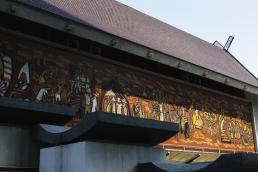Museums are a feature of modern nation-states. On the surface, museums act as a display room for the country’s history. But the museum is more like an art gallery; designed as a carefully curated experience. It intends to tell a story of the nation through a calculated selection of its exhibits; how and where the artefacts are placed in relation to each other, and the experience of moving through the gallery spaces1Macleod, S., Hourston Hanks, L. and Hale, J. eds. (2012). Museum Making: Narratives, Architectures, Exhibitions. 1st ed. Routledge..

This is true for all museums. Publicly or privately funded. Certainly, the truth of a curated space is true as well for Muzium Negara, Malaysia’s national museum located in Kuala Lumpur. In over the decade of my visits to Muzium Negara, the exhibitions always remained the same: four main galleries, with a seasonal exhibition in the centre hall.
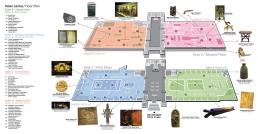
The fee to enter the museum is RM2. After which, you are guided by design to enter the left entrance where the information counter is located. Incidentally, this brings you close to the entrance of the Malay Kingdoms gallery. Naturally, you would enter the gallery closest to yourself. Never mind that the Malay Kingdoms gallery is designated as B – second.
The Malay Kingdoms

When first entering the Malay Kingdoms gallery, one is invited to walk through the 120-year-old Setul Palace Door and Walls2Siew Yen, A.C. (2020). A walk through Gallery B, Muzium Negara. Museum Volunteers, JMM. Available from: https://museumvolunteersjmm.com/2020/08/23/a-walk-through-gallery-b-muzium-negara/. Immediately, there is a sense that you are entering a sacred, grand space beyond the open wooden doors. The early exhibits zoom out, narrating the shared history of the Archipelago and the broadening narrative strokes that include Java, the Philippines and the serumpun neighbour states. The emphasis of an ancient Malay civilisation that practised Hindusim and Buddhism is also clear here.


But no Malaysian history is complete without pinpointing the genesis of the Melaka Empire. The exhibition unfolds by presenting trade and natural resources as contributing factors to its rise, and the eventual structuring of a political-governance system. Once you get over the brief history lesson of Melaka, in which the myth of the mousedeer and dog (and how the state got its name) is amusingly absent – you bear witness to a diorama that recreates the Sultan Megat Iskandar Shah’s embracing of Islam, and by consequence, all his subjects under the Sultanate.

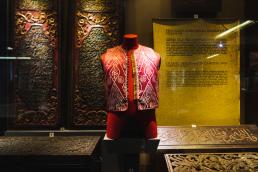
The following exhibitions did much to show the influence of Islam on various facets of Malay-Melaka civilised life, with a close focus on design and everyday wares. This extended to show fashion and daily life even outside the influences of Islam, which feels like a fairer representation of Malay cosmopolitanism.

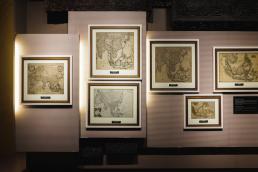
Although the Malay Kingdom gallery’s “natural” end is a cartographic display of old maps representing the region, one could return clockwise into the inner exhibitions. Here, there is an array of blades used in daily life, such as for cooking and farming but also emphasised that these tools could also double for self-defence, and no doubt, war.

Finishing off the Malay Kingdom’s exhibitions are items related to the Sultanate. The presence of the Singgahsana Perak (Perak Royal Throne) in the middle of the room in bright yellow-gold illuminates the entire room that is primarily in darkness. But it also gives an impression of a cultural institution holding on to the past: an empty seat amidst ancient history. The throne’s central position attempts to exert itself but somehow lacks real draw. It is no coincidence then, that it is directly opposed to the mural of Hang Tuah.
The mural, clearly contemporary, pictures the life and deeds of the fabled Malay warrior. TA’ MELAYU HILANG DI-DUNIA is etched above the mural – a famous phrase often repeated by many. Most of all by Bumiputera nationalists. Waveney Jenkins designed the Hang Tuah mural in 1963, a curious choice for what is now a lightning rod for contemporary socio-political issues3Jenkins, W. (2013). Notes on the setting up of Muzium Negara 1960s. Berita JMM, 14(2), pp.16–18.. The placement of the mural is calculated when considering that it was facing the throne and the Sultanate exhibition. There is an unspoken expectation that this is the institution that the Bumiputera-Malays are supposed to protect. Lest their identity is lost to time, tide, and society. The plaque clarifies this, indicating Hang Tuah as a loyal admiral to the Sultan. This, however, omits the figure’s more complex post-Jebat battle, cosmopolitan humanist that redefines the phrase4Noor, F.A. (2009). What Your Teacher Didn’t Tell You: The Annexe Lectures. Petaling Jaya, Selangor: Matahari Books..
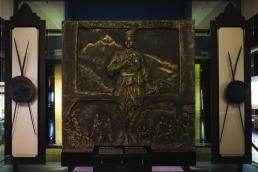
Early History
It is easy to skip over or find the Early History gallery one of the museum’s more uninteresting exhibitions. There is nothing to politicise of pre-historic homo sapiens, and no lighting rod to channel modern concerns. The movement direction in this gallery, however, is interesting as it moves counter-clockwise. It is the only gallery among the four where one reverses in the flow of time and direction.
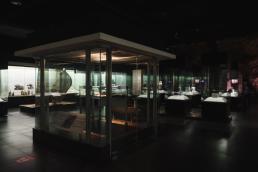
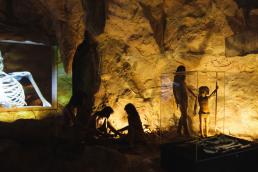
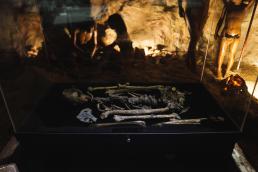
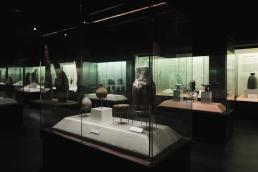
It begins with a sober introduction of proto-humans, skeletons, and tools, but ends with a symbolic entry into early Malay civilisation via a miniaturised replica of a Lembah Bujang Valley candi (temple). It is an ingenious arrangement – indicating to the visitor that a depoliticised past is irrelevant and that one must inevitably arrive at where they began: the Malay Kingdom. Of when the importance of empires and identity became prominent.
The anti-clockwise walk through the Early History gallery achieves just that.

When one exits from the Early History gallery, they end up back in the main hall. Incidentally, near the staircase that leads them up to the second floor of the museum. The split staircase allows one to go to either side of the hall, but by design, one would almost always take right – up to the Colonial Era gallery. This is because the exit of the Early History gallery is located towards the right side of the staircase.
In a way, when one exits from the country’s depoliticised early history, they are redirected back into the normal stream of conscious time. This is important to note because when one first enters the museum and is directed by design into the Malay Kingdoms gallery, they are introduced to the curator’s intent to set the narrative and meaning-making tone. The following sequence of the Early History gallery breaks the narrative stream – both space and time-wise, only to return to the intended stream of chronological time.
The Colonial Era
The Colonial Era gallery, while having the potential to be as equally interesting as the Malay Kingdoms, lacks the critical reflection necessary for such a traumatic period in national history. As with the return to the chronological stream, so does the individual as they are directed to navigate in a clockwise direction.
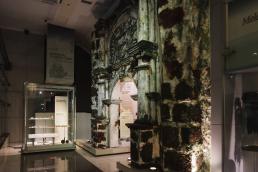
The Colonial Era begins with the invasion of the Portuguese, emphasising their military technology and approach. This theme of conquering and military invasion continues with the Dutch, where at one point has the visitor pass under the archway of an A’Famosa replica. By the time one reaches the midpoint of the gallery, the narrative switches over to the British Empire. For the British, there is a strong emphasis on political deception and power play. This is unlike the former two colonising forces, where their exhibitions are focused on military might.
Here, much is discussed on how the Malay Rulers were coerced into submitting to the British administration. Little is mentioned of the political benefits gained by the Rulers during the administrative takeover, although hints of in-fighting and governance weakness are given a brief mention5Raja, S.S. (2021). Malay Aristocrats’ Participation in Business in Colonial Malaya. In R. Rasiah, A. Hashim, & J. S. Sidhu, eds. Contesting Malaysia’s Integration into the World Economy. Singapore: Springer, pp. 145–168. Available from: https://doi.org/10.1007/978-981-16-0650-2_7.6Arifin, A. (2012). Perak Disturbances 1871-75: British Colonialism, The Chinese Secret Society and The Malay Rulers. Jebat: Malaysian Journal of History, Politics & Strategic Studies, 39(1), pp.51–76.. Despite this, reverence is paid to British rule as one transition into the next section. Here, there are exhibitions on Malaya’s economic and technological growth, as though almost whitewashing the British occupation.

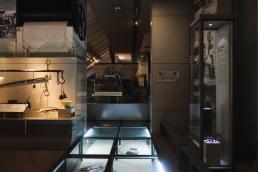
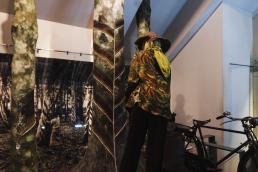

In some odd parallel, this transition from political deception to economic benefit is akin to a short burst of necessary anger before becoming bedfellows. It is essentially saying: yes, we relinquished power and national destiny to the British, but at least look at what we gained in return. This is unsurprising, given our cordial relationship with the modern-day United Kingdom and our inclusion into the Commonwealth. It is worth acknowledging that our current political and economic system is of British heritage – so this may explain the more forgiving outlook towards our relationship (and to this extent, how they are presented) despite past transgressions7Brodie, T.V.A. (1962). Malaya and Singapore: The Borneo Territories. Volume 9 of The British Commonwealth, The Development of its Laws and Constitutions L. A. Sheridan, ed. International & Comparative Law Quarterly, 11(3), pp.906–910..
After the exhibits on the economic goals during the British administration, we move to the Japanese Occupation. This is exemplified by wartime imagery. The major exhibit is a Japanese bicycle and the equipment and uniforms of an invading Japanese soldier. This section is also scant – parallel to the short occupation years. When I say wartime imagery, this also includes a bunker exhibit where one can “peer out” into a wartime scene.
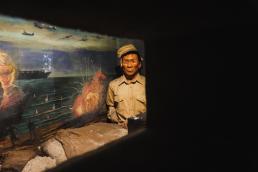
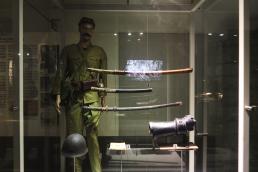

One notable aspect towards the end of the colonial-era journey is the inclusion of a snippet of a documentary. The clip features the late Siti Rahmah Kassim, a then-Umno activist who was active in advocating for Malayan independence. She is most well-known for selling her gold bangle to help fund Tunku Abdul Rahman’s trip to London to negotiate for Malayan Independence8Ishak, M. (2015). Korban gelang kahwin demi kemerdekaan. Berita Harian. Available from: https://www.bharian.com.my/bhplus-old/2015/08/78506/korban-gelang-kahwin-demi-kemerdekaan.. This is the only time that there is an overt political shred in the entire Muzium Negara experience.
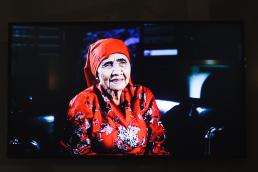
I must admit that the nuance missing from the Japanese Occupation was the historical fact of the Malays being favourable with the Japanese occupation as it fed into the nationalist and anti-colonial agenda of the time9Soh, B. (1998). Malay Society under Japanese Occupation, 1942–45. International Area Review, 1(2), pp.81–111.. This section understandably whitewashes that historical fact. The Colonial Era gallery ends abruptly, almost cliff-hanger-like.
Malaysia Today
This brings us to the final gallery: Malaysia Today. The gallery begins by putting us right in the build-up to the Malayan Independence. This part of the experience is supposed to exemplify the building blocks of nation-building. While the left side of the room discusses the spirit of Independence via nationalism and political awakening, the right side of the room, interestingly, lists the crimes of Parti Komunis Malaya (PKM). It is unmissable. An entire, red-backdropped wall laundry lists the insurgency’s aggressions. This juxtaposition is calculated. The road to Independence and the obstacles that threaten it.


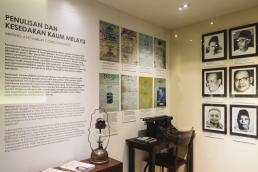
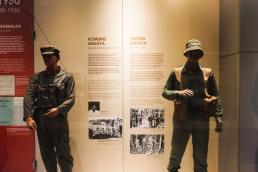
But good triumphs, and at the peak, an entire section is dedicated to the moment of Independence. Nothing is outstanding in this section. It is, after all, when the difficult conversation begins. How do we begin to make sense of ourselves as a nation, and a people?
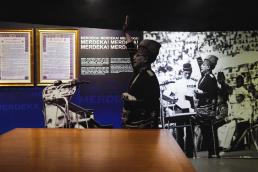
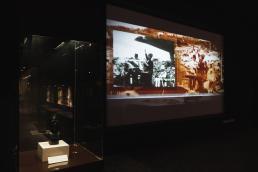
As soon as one exits the glory of Malayan Independence, Malaysia is threatened. Mini panels detail Konfrontasi, our armed conflict with Indonesia, as well as Singapore’s eventual separation. Once we move over existential threats, both external and internal, we still have to come to terms with living together.
From here on, the gallery and its exhibitions become sanitised. In this particular section, the hollow promise of muhhibah is present. An entire exhibition is uncharacteristically dedicated to a large, very basic map of Malaysia. Unlike the detailed cartographic exhibitions in the Malay Kingdoms gallery, the Malaysian map here feels rudimentary – an afterthought, almost. Opposite the map is two other exhibits: the Parliament Speaker’s chair and a brief explanation of Malaysia’s democratic institution.
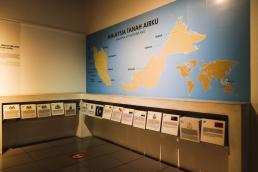

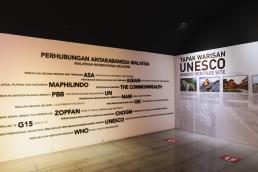
As one leaves this section and moves towards the end, we are faced with a forced diversity display. On one side, the traditional wear of the different ethnicities, and on the other, a representation of the different festivities.
Something is telling, in particular, when this diversity section feels empty, hollow, and frozen. Textbook. There is much to say about how Malaysia’s inter-ethnic relationships have evolved since. The erasure of May 13, 1969, for example, is an obvious omission that indicates the difficulty objectivity of curating history. In the decades since 1957, Malaysia has wrestled with itself and continues to do so. But what is certain is that this particular section is an empty ideal and a caricature. To be certain, it is outdated. One ends the Malaysia Today gallery feeling cheated and let down. The thesis of Malaysia that Muzium Negara’s narration wants us to believe in, or aspire to, is unrealistic.
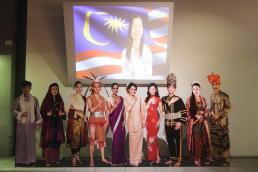

Final thoughts
As far as exhibits go, there is certainly a calculated narrative for Muzium Negara and how it utilises both space and meaning-making with its exhibitions. Particularly, it is evident in how the museum sets the tone with the Malay Kingdoms gallery. Political agenda exists in its subtleties. That, I suppose, is the thing with art and curation in general – it is an unspoken conversation.
In this essay, I have attempted to read the spaces I engaged with. I also attempted to critically assess the experience of Muzium Negara’s curated journey. Unfortunately, I am disappointed with the lack of nuance, while on the other hand, I am certainly impressed with the level of thinking that went behind this curated narration.
